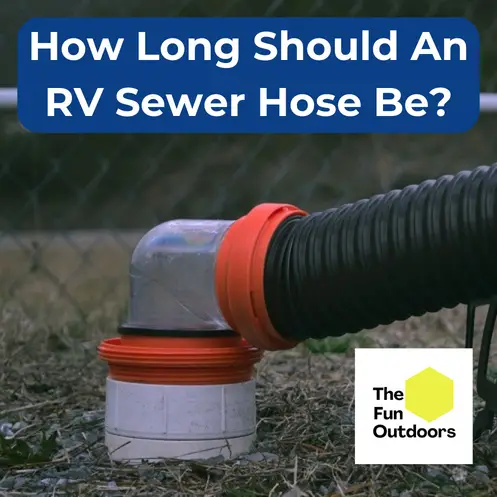RVing is a fun and exciting way to explore the great outdoors, but it also comes with its fair share of dirty work. One of the less glamorous tasks is emptying your RV’s waste tanks. But how long should an RV sewer hose be?
An RV sewer hose should be at least 20 feet long, with a 25 foot length being better. There are several factors that come into play, such as the distance between your RV and the sewer outlet, the slope of the ground, and the type of RV you have.
We’ll take a closer look at each of these factors and how they influence the ideal length of an RV sewer hose in this article.
Key Takeaways
- Experts recommend getting an RV sewer hose that’s between 20 and 25 feet long.
- The ideal length of an RV sewer hose depends on several factors, including the distance between your RV and the sewer outlet, the slope of the ground, and the type of RV you have.
- A good RV sewer hose should be durable, easy to clean, and have secure connections.
RV Sewer Hose Basics
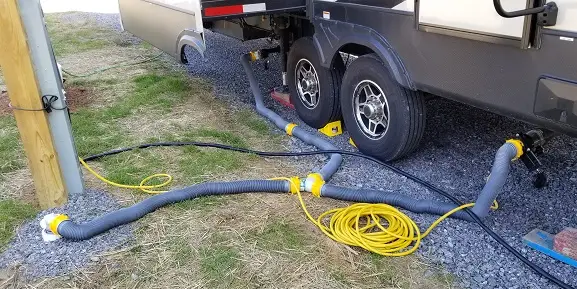
When it comes to RVing, there are certain things that are just not glamorous, and one of those things is dealing with the sewage.
It’s a necessary part of the lifestyle, and having the right equipment can make all the difference. In this section, we’ll go over some basic information about RV sewer hoses.
First things first, let’s talk about the length of the hose. The length of your RV sewer hose is important because it determines how far away from the dump station you can park your RV.
Ideally you should get an RV sewer hose that’s between 20 and 25 feet long, which will cover nearly any situation you may find yourself in.
Some experts recommend two hoses, one 10 foot and one 15 foot that can be connected together for the maximum versatility.
Many sewer hoses come in that length already. If your hose won’t stretch from the rig’s rear to your sewage dump outlet, it’s too short.
Another thing to consider is the material of the hose.
The most common material for RV sewer hoses is vinyl. It’s lightweight, flexible, and affordable.
However, vinyl hoses are not as durable as other materials and can crack over time.
If you’re looking for a more durable option, consider a hose made of polyolefin or thermoplastic elastomer.
It’s also important to note that not all hoses are created equal.
Some hoses have a smooth interior, while others have ridges or bumps.
A smooth interior is preferable because it allows for better flow and reduces the chance of clogs.
Lastly, it’s important to properly store your RV sewer hose.
A lot of people swear by storing their sewer hose in a five-gallon bucket inside an underneath storage compartment.
It’s a good idea to clean and store your hose outside of your RV’s main storage areas if possible.
This will help prevent any unwanted odors from seeping into your living space.
Overall, having the right RV sewer hose can make the unpleasant task of dumping your tanks a little less unpleasant.
By considering the length, material, and interior of the hose, you can ensure that you have the right equipment for the job.
How Long Should an RV Sewer Hose Be?
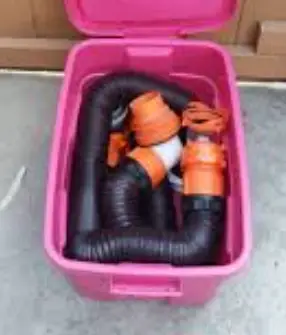
When it comes to RV sewer hoses, length matters. Having the right length of sewer hose can make all the difference in avoiding embarrassing and messy situations.
So, how long should an RV sewer hose be?
Experts recommend getting a RV sewer hose that’s between 20 and 25 feet long. This length is typically long enough to reach from the rig’s rear to your sewage dump outlet.
If your hose won’t stretch that far, it’s too short.
However, keep in mind that longer isn’t always better.
A longer hose can be cumbersome to handle and store. It can also result in slower drainage due to the increased distance between the RV and the dump station.
Another factor to consider is the slope of the hose.
For optimal flow, the hose should be sloped downward from the RV to the dump station.
This will ensure that all waste and water flow out of the tank and into the dump station.
See Related: How to Make a DIY RV Sewer Hose Support
In addition to length and slope, it’s important to choose a high-quality sewer hose that is durable and leak-resistant.
Cheaper hoses may save you money upfront, but they can lead to messy and unpleasant situations down the road.
Overall, finding the right length of RV sewer hose is essential for a smooth and stress-free camping experience.
So, be sure to measure the distance from your RV to the dump station and choose a hose that’s long enough, but not too long.
Factors Influencing Hose Length
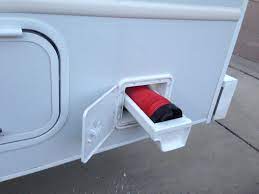
When it comes to choosing the right length for your RV sewer hose, there are several factors to consider. We’ve compiled a list of the most important factors to help you make an informed decision.
1. RV Length
The length of your RV is one of the most important factors to consider when choosing a sewer hose.
A longer RV will require a longer hose to reach the dump station. As a general rule, you should choose a hose that is at least as long as your RV.
2. Campground Facilities
The facilities at the campground you plan to stay at can also influence the length of your sewer hose.
Some campgrounds have dump stations that are located further away from the campsites, which may require a longer hose.
It’s always a good idea to check the campground’s website or call ahead to find out the distance from your campsite to the dump station.
3. Personal Preferences
Your personal preferences can also play a role in determining the length of your sewer hose.
Some RVers prefer a longer hose to provide more flexibility and avoid any potential mishaps.
Others prefer a shorter hose to minimize the amount of hose they need to handle and store.
4. Budget
The cost of a sewer hose can also be a factor in determining the length you choose.
Longer hoses tend to be more expensive than shorter ones, so it’s important to consider your budget when making a decision.
Expandable RV Hoses: Are They Any Good?
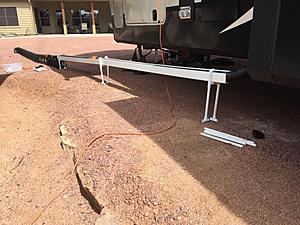
When it comes to choosing a sewer hose for our RV, we’ve come across expandable hoses.
These hoses are marketed as being more compact and easier to store, but are they any good?
After doing some research and testing, we’ve found that expandable RV hoses do have some benefits, but also some drawbacks.
Benefits of Expandable RV Hoses
- Compact: One of the main benefits of expandable hoses is that they can be collapsed down to a smaller size, making them easier to store in tight spaces.
- Lightweight: Since they are made of thinner materials, expandable hoses are generally lighter than traditional hoses.
- Flexible: Expandable hoses are more flexible than traditional hoses, which can be useful when trying to navigate around obstacles.
Drawbacks of Expandable RV Hoses
- Durability: Expandable hoses are made of thinner materials, which can make them more prone to punctures and leaks.
- Length: While expandable hoses can stretch to a longer length, they are generally shorter than traditional hoses when collapsed down to their compact size.
- Compatibility: Expandable hoses may not be compatible with all RV sewer connections, so it’s important to check before purchasing.
Overall, expandable RV hoses can be a good option for those who are short on storage space or need a more flexible hose.
They may not be as durable or compatible as traditional hoses, so it’s important to weigh the pros and cons before making a purchase.
Ideal Sewer Hose Length for Different RV Types
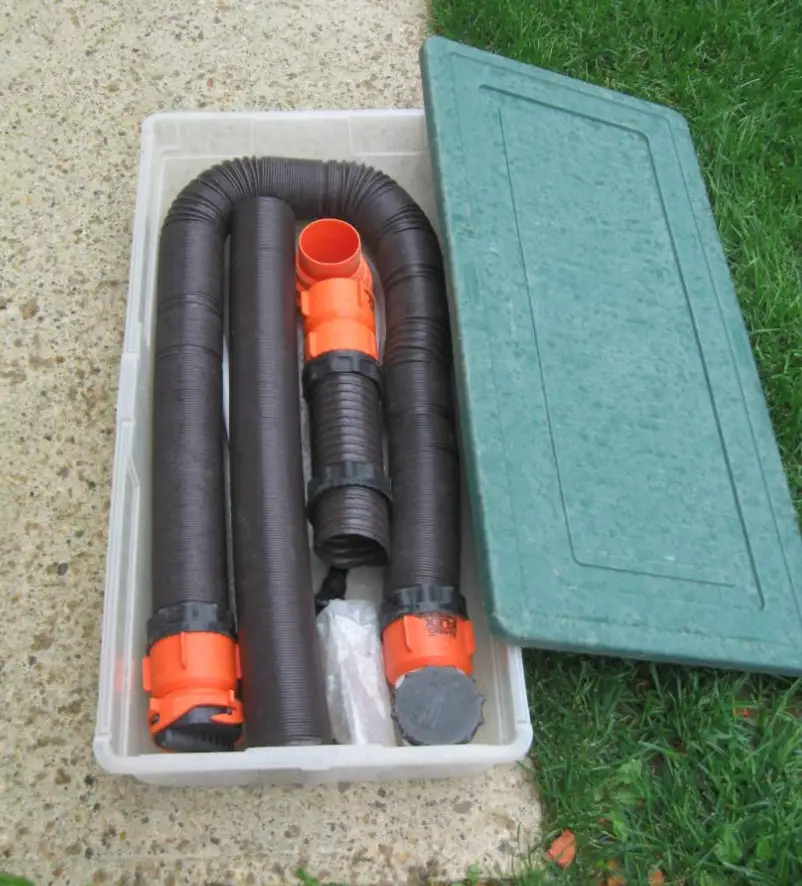
When it comes to RV sewer hoses, the ideal length can vary depending on the type of RV you have. Here are some guidelines to help you choose the right length of sewer hose for your rig:
Class A Motorhomes
Class A motorhomes are the largest type of RV, so you’ll need a longer sewer hose to reach the dump station.
We recommend getting a hose that’s at least 20 feet long, but you may want to go up to 30 feet just to be safe.
Class B and C Motorhomes
Class B and C motorhomes are smaller than Class A’s, so you can get away with a shorter sewer hose.
A hose that’s 20-25 feet long should be sufficient for most situations.
Travel Trailers and Fifth Wheels
Travel trailers and fifth wheels come in a variety of sizes, so the length of sewer hose you need will depend on the length of your rig.
As a general rule, we recommend getting a hose that’s at least 20 feet long.
Pop-Up Campers
Pop-up campers are the smallest type of RV, so you won’t need a very long sewer hose. A hose that’s 10-20 feet long should be sufficient for most pop-up campers.
Remember, it’s always better to have a sewer hose that’s too long than one that’s too short.
You don’t want to be stuck in a situation where you can’t reach the dump station because your hose isn’t long enough.
So, when in doubt, go for a longer hose.
What Makes a Good RV Sewer Hose?
When it comes to RV sewer hoses, there are a few key features that make a hose stand out from the rest.
Here are the top characteristics that we look for in a good RV sewer hose:
Easy To Use
A good RV sewer hose should be easy to use. This means that it should be simple to connect to your RV’s holding tank and to the dump station.
A hose with a bayonet fitting can be especially easy to use, as it can be securely twisted onto the RV’s holding tank outlet.
Additionally, a hose with a clear elbow can make it easy to see when the tank is fully emptied.
Easy To Clean
Cleaning an RV sewer hose is not a pleasant task, but it’s important to keep the hose clean to prevent odors and bacteria buildup.
A good RV sewer hose should be easy to clean. Hoses made of smooth plastic or vinyl are often easier to clean than ribbed hoses.
Additionally, a hose with a detachable fitting can make it easier to thoroughly clean the hose.
Portable
RVers need to be able to take their sewer hose with them on the road. A good RV sewer hose should be portable and lightweight.
Hoses made of thin, durable plastic are often the best option for portability.
Additionally, a hose that can be compressed or collapsed for storage can save valuable space in your RV.
Easy To Store
When you’re not using your RV sewer hose, you need a place to store it. A good RV sewer hose should be easy to store.
Hoses that can be compressed or collapsed for storage can save valuable space in your RV.
Additionally, hoses with storage bags or compartments can help keep the hose organized and protected from damage.
Accepts Different Attachments
Different dump stations may require different attachments for the sewer hose.
A good RV sewer hose should be able to accept different attachments.
Hoses with universal fittings can be especially useful, as they can connect to a variety of dump stations without requiring additional adapters.
Overall, a good RV sewer hose should be easy to use, easy to clean, portable, easy to store, and able to accept different attachments.
With the right sewer hose, you can make the dirty job of dumping your RV’s holding tank a little bit easier.
See our related guides on RV black tanks and other related info before you go:

